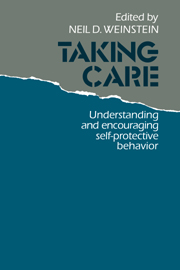Book contents
- Frontmatter
- Contents
- List of contributors
- Acknowledgments
- Introduction: studying self-protective behavior
- I Theoretical perspectives
- 1 Behavioral decision theory perspectives on protective behavior
- 2 Social learning theory and preventive behavior
- 3 The role of emotion and psychological defense in self-protective behavior
- 4 The diffusion of innovations perspective
- 5 Cultural influences on prevention and the emergence of a new health consciousness
- II Research and prevention programs for specific hazards
- III Conclusion
- Index
3 - The role of emotion and psychological defense in self-protective behavior
Published online by Cambridge University Press: 03 February 2010
- Frontmatter
- Contents
- List of contributors
- Acknowledgments
- Introduction: studying self-protective behavior
- I Theoretical perspectives
- 1 Behavioral decision theory perspectives on protective behavior
- 2 Social learning theory and preventive behavior
- 3 The role of emotion and psychological defense in self-protective behavior
- 4 The diffusion of innovations perspective
- 5 Cultural influences on prevention and the emergence of a new health consciousness
- II Research and prevention programs for specific hazards
- III Conclusion
- Index
Summary
Early and provident fear is the mother of safety.
Edmund BurkeIntroduction
As a young woman was driving to work one wintry morning, her car hit a patch of ice and veered into oncoming traffic. What might the young woman have experienced as she felt her car go out of control and head for a possibly fatal accident? Fear, most likely. But what is fear? Perhaps the young woman felt her heart pound and a sinking feeling in the pit of the stomach; her thoughts may have raced, but without coherence; and perhaps she engaged in frantic maneuvers, or simply froze at the wheel. These are all typical manifestations of fear. But it is also possible (and commonly reported in such instances) that the young woman's attention was so riveted on controlling the vehicle and taking evasive action that none of these symptoms of fear was evident. Was she then lacking in fear?
Assume the evasive actions were successful, and the young woman's car reached the other side of the road without a collision. Also assume, for the sake of argument, that the car overturned on an embankment and was totally wrecked. The young woman fortunately escaped injury because she was wearing a seat belt. Only after the car had come to rest did she lose her composure, start to tremble, and break out in a cold sweat. Was she then experiencing fear, even though she knew the danger had passed?
- Type
- Chapter
- Information
- Taking CareUnderstanding and Encouraging Self-Protective Behavior, pp. 54 - 78Publisher: Cambridge University PressPrint publication year: 1987
- 9
- Cited by



